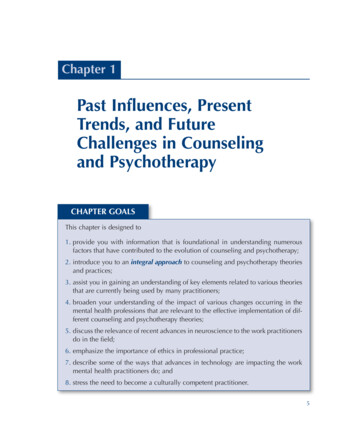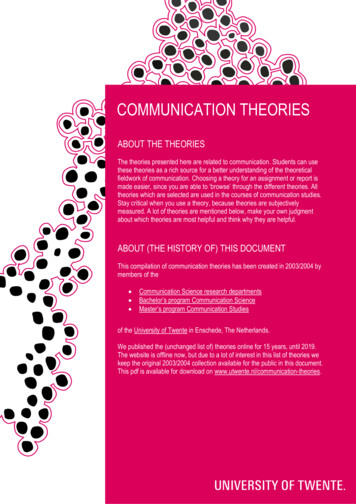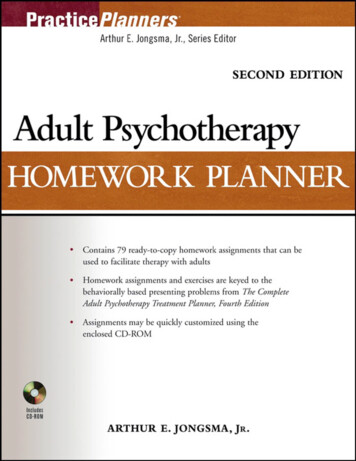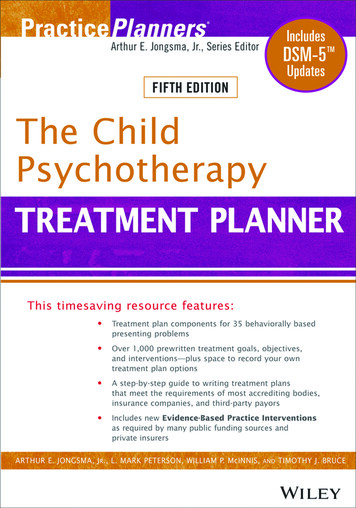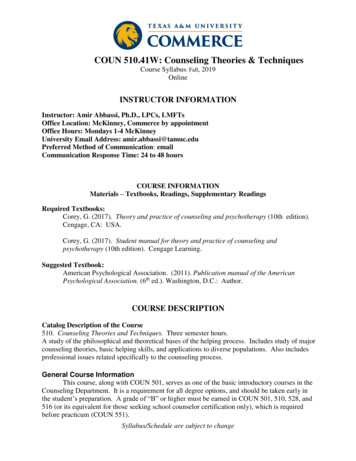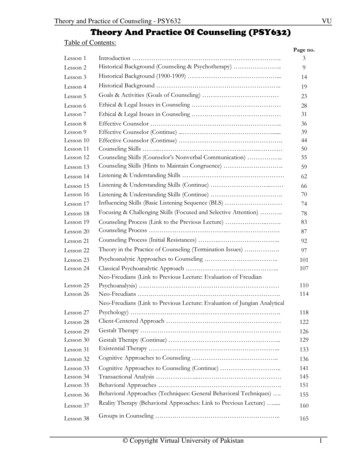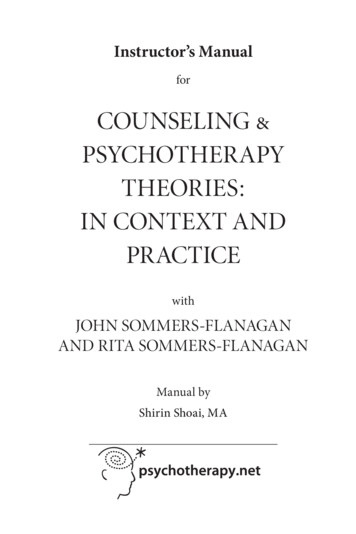
Transcription
Instructor’s ManualforCOUNSELING &PSYCHOTHERAPYTHEORIES:IN CONTEXT ANDPRACTICEwithJOHN SOMMERS-FLANAGANAND RITA SOMMERS-FLANAGANManual byShirin Shoai, MA
COUNSELING & PSYCHOTHERAPY THEORIES: IN CONTEXT AND PRACTICEThe Instructor’s Manual accompanies the video Counseling & PsychotherapyTheories: In Context and Practice with John Sommers-Flanagan and RitaSommers-Flanagan (Institutional/Instructor’s Version). Video available atwww.psychotherapy.net.Copyright 2014, Psychotherapy.net, LLC. All rights reserved.Published by Psychotherapy.net150 Shoreline Highway, Building A, Suite 1Mill Valley, CA 94941Email: contact@psychotherapy.netPhone: (800) 577-4762 (US & Canada)/(415) 332-3232Teaching and Training: Instructors, training directors and facilitators usingthe Instructor’s Manual for the video Counseling & Psychotherapy Theories:In Context and Practice with John Sommers-Flanagan and Rita SommersFlanagan may reproduce parts of this manual in paper form for teachingand training purposes only. Otherwise, the text of this publication may notbe reproduced, stored in a retrieval system, or transmitted in any form or byany means—electronic, mechanical, photocopying, recording or otherwise—without the prior written permission of the publisher, Psychotherapy.net. Thevideo Counseling & Psychotherapy Theories: In Context and Practice with JohnSommers-Flanagan and Rita Sommers-Flanagan (Institutional/Instructor’sVersion) is licensed for group training and teaching purposes. Broadcastingor transmission of this video via satellite, Internet, video conferencing,streaming, distance learning courses or other means is prohibited without theprior written permission of the publisher.Shirin Shoai, MACounseling & Psychotherapy Theories: In Context and Practice with JohnSommers-Flanagan and Rita Sommers-FlanaganCover design by Julie GilesOrder Information and Continuing Education Credits:For information on ordering and obtaining continuing education creditsfor this and other psychotherapy training videos, please visit us atwww.psychotherapy.net or call 800-577-4762.2
Psychotherapy.netInstructor’s Manual forCOUNSELING & PSYCHOTHERAPYTHEORIES: IN CONTEXT AND PRACTICEWITH JOHN SOMMERS-FLANAGAN ANDRITA SOMMERS-FLANAGANTable of ContentsTips for Making the Best Use of the Video4The Sommers-Flanagans’ Approach to Counseling and PsychotherapyTheories6Discussion Questions13Role-Plays18Reaction Paper Guide for Classrooms and Training20Related Websites, Videos and Further Readings21Transcript24Video Credits167Earn Continuing Education Credits for Watching Videos168About the Contributors169More Psychotherapy.net Videos1703
COUNSELING & PSYCHOTHERAPY THEORIES: IN CONTEXT AND PRACTICETips for Making the Best Use of theVideo1. USE THE TRANSCRIPTSMake notes in the video Transcript for future reference; the next timeyou show the video you will have them available. Highlight or notatekey moments in the video to better facilitate discussion during and afterthe video.2. FACILITATE DISCUSSIONPause the video at different points to elicit viewers’ observations andreactions to the concepts presented. The Discussion Questions sectionsprovide ideas about key points that can stimulate rich discussions andlearning.3. ENCOURAGE SHARING OF OPINIONSEncourage viewers to voice their opinions. What are viewers’impressions of what is presented in the interviews?4. CONDUCT A ROLE-PLAYThe Role-Play sections guide you through exercises you can assign toyour students in the classroom or training session.5. SUGGEST READINGS TO ENRICH VIDEO MATERIALAssign readings from Related Websites, Videos and Further Readingprior to or after viewing.6. ASSIGN A REACTION PAPERSee suggestions in the Reaction Paper section.4
Psychotherapy.netPERSPECTIVE ON VIDEOS AND THE PERSONALITY OF THECLINICIANPsychotherapy portrayed in videos is less off-the-cuff than therapyin practice. Clinicians may feel put on the spot to offer a gooddemonstration, and clients can be self-conscious in front of a camera.Clinicians often move more quickly than they would in everydaypractice to demonstrate a particular technique. Despite these factors,counselors and clients on video can engage in a realistic session thatconveys a wealth of information not contained in books or therapytranscripts: body language, tone of voice, facial expression, rhythm ofthe interaction, quality of the alliance—all aspects of the therapeuticrelationship that are unique to an interpersonal encounter.Psychotherapy is an intensely private matter. Unlike the training inother professions, students and practitioners rarely have an opportunityto see their mentors at work. But watching therapy on video is the nextbest thing.One more note: The personal style of therapists is often as importantas their techniques and theories. Counselors are usually drawn toapproaches that mesh well with their own personality. Thus, while wecan certainly pick up ideas from master clinicians, students and traineesmust make the best use of relevant theory, technique and research thatfits their own personal style and the needs of their clients.PRIVACY AND CONFIDENTIALITYBecause this video contains actual counseling sessions, please takecare to protect the privacy and confidentiality of the clients who havecourageously shared their personal lives with us.5
COUNSELING & PSYCHOTHERAPY THEORIES: IN CONTEXT AND PRACTICEThe Sommers-Flanagans’ Approach toCounseling and Psychotherapy Theories*The study of counseling and psychotherapy encompasses a wide arrayof theoretical approaches, each with its own history, focus, strategies,and techniques. An overview of the basic tenets and interventions of anapproach can support beginning therapists in their understanding ofthe counseling field as a whole, and their individual leanings toward aparticular orientation.In this video, John Sommers-Flanagan and Rita Sommers-Flanaganpresent eleven different theory-based orientations, with extended casedemonstrations featuring actual clients and clinicians.Psychoanalytic (or psychodynamic) therapyPsychoanalytic or psychodynamic psychotherapy is a form of clinicalpractice based on psychoanalytic theory and principles. These multipletheories focus on increasing self-understanding and deepening insightinto emotional issues and conflicts that underlie the presentingdifficulties.Typically, therapists pay particular attention to the exploration ofunconscious thoughts and feelings, understanding aspects of therelationship between therapist and client—which may relate tounderlying emotional conflicts—interpretation of defensive processesthat obstruct emotional awareness, and consideration of issues relatedto one’s sense of self and self-esteem. The focus is on exploration ofthe patient’s inner experience, emphasizing this as it occurs in currentdaily life, as it carries over from significant and influential eventsand relationships of the past, and as it manifests in the context of thetherapeutic relationship.Adlerian therapyAdlerian therapy is a “highly practical” precusor to cognitive-behavioraltherapy (see below) that emphasizes an individual’s characteristic waysof moving through the specific world, or context, in which they live. It6
Psychotherapy.netpresumes that people who seek therapy are discouraged rather than sick,and that they seek to make decisions and reach goals that will facilitatetheir growth.Adlerian therapy emphasizes thorough assessment of clients’ birthorder, family relationships, and early memories as a vehicle throughwhich to gain understanding of clients’ individual ways of approachingthe world—what Adlerians call “lifestyle.”Starting with an interview process that delineates the phenomenologicalperceptions of the family system (that is, a description of what Adlercalled the family constellation), modern Adlerian family therapy isdesigned to recognize and disclose the mistaken goals involved in adultchild interactions.Existential therapyExistential therapy focuses on meaning. The job of the therapist is tolisten for what is important or meaningful to the client, supporting thedevelopment of self-awareness and a life lived authentically even in theface of death, illness, or other life concerns. Therapists work from anI-Thou perspective, one of deep respect of the other while remaininggenuine and spontaneous.Existential therapy emphasizes clients’ process over the content of theirwords. The goal of such process comments is to help clients increaseawareness of their own experience, including restrictive patterns andhabits, so they can access more of themselves, make choices abouttheir feelings and behavior (rather than being on automatic pilot), andultimately live life more fully.Person-centered therapyPerson-centered psychotherapy (also known as client-centered orRogerian therapy) is a form of talk therapy developed by Carl Rogers inthe 1940s and 1950s. Congruence, unconditional positive regard, andempathic understanding are the three core conditions of the personcentered approach to psychotherapy. For the person-centered therapist,7
COUNSELING & PSYCHOTHERAPY THEORIES: IN CONTEXT AND PRACTICEit’s necessary and sufficient to adopt three core conditions—attitudesof empathy, congruence and unconditional positive regard—thatlead to the emergence of the self. The purpose of this form of therapyis to increase a person’s feelings of self-worth, reduce the level ofincongruence between the ideal and actual self, and help a personbecome more fully functioning.Gestalt therapyGestalt therapy is a phenomenological-existential therapy developedby Frederick (Fritz) and Laura Perls in the 1940s. It teaches therapistsand patients the phenomenological method of awareness and directexperience, in which perceiving, feeling, and acting “in the now” aredistinguished from interpreting and reshuffling preexisting attitudes.The goal is for clients to become aware of what they are doing, how theyare doing it, and how they can change themselves, and, at the same time,to learn to accept and value themselves.Awareness is accompanied by owning, that is, the process of knowingone’s control over, choice of, and responsibility for one’s own behaviorand feelings. Without this, the person may be vigilant to experience andlife space, but not to what power he or she has and does not have.All techniques of patient focusing are elaborations of the question,“What are you aware of (experiencing) now?” and the instruction,“Try this experiment and see what you become aware of (experience)or learn.” A frequent technique is to follow an awareness report withthe instruction to “stay with it” or “feel it out.” Additional techniquesinclude enactments, exaggerations, the “empty chair” technique, bodyand “contact boundary” awareness, and therapist self-disclosure.Behavior therapyBehavior therapy is focused on helping an individual understand howchanging their behavior can lead to changes in how they are feeling. Thegoal of behavior therapy is usually focused on using natural incentivesto increase engagement in positive or socially reinforcing activities.In general, behavior therapy is seen as having three distinct points oforigin: South Africa (Joseph Wolpe), The United States (B.F. Skinner),8
Psychotherapy.netand the United Kingdom (Stanley Rachman and Hans Eysenck). Eachhad its own distinct approach to viewing behavior problems. Skinner’sgroup took more of an “operant conditioning” focus, which createda functional approach to assessment and interventions focused oncontingency management such as the token economy and behavioralactivation.Behavior therapy is a structured approach that carefully measures whatthe person is doing and then seeks to increase chances for positiveexperience. With a focus on rewards—reinforcers that create andmaintain positive behavior—and appropriate punishments that reducethe rate of maladaptive behavior, behavior therapy is well suited toclients needing to make significant, rather quick behavioral changes.Most behavior therapists use objective assessment methods likestructured interviews, objective psychological tests or differentbehavioral rating forms. When making a behavioral assessment thebehavior therapist wants to answer two questions: (1) what are thedifferent factors (environmental or psychological) that are maintainingthe maladaptive behavior and (2) what type of behavior therapy ortechnique that can help the individual improve most effectively. Byhaving this baseline, as therapy continues this same measure canbe used to check a client’s progress, which can help determine if thetherapy is working. Most behavior therapists now acknowledge andwork with cognition.Cognitive-behavioral therapy (CBT)Cognitive-Behavioral Therapy (CBT) is a general classificationof psychotherapy, and several approaches to CBT fall within thisclassification, including Rational Emotive Behavior Therapy, CognitiveTherapy, Rational Behavior Therapy, Rational Living Therapy, SchemaFocused Therapy, and Dialectical Behavior Therapy. Each approach hasits own developmental history.The first discrete, intentionally therapeutic approach to CBT to bedeveloped was Rational Emotive Therapy (RET), which was originatedby Albert Ellis, Ph.D. in the mid-1950s. In the 1990s Ellis renamed his9
COUNSELING & PSYCHOTHERAPY THEORIES: IN CONTEXT AND PRACTICEapproach Rational Emotive Behavior Therapy. In the 1960s, Aaron Beck,M.D. developed his approach called Cognitive Therapy. Beck’s approachbecame known for its effective treatment of depression.Today, CBT comprises a variety of procedures, such as cognitiverestructuring, stress inoculation training, problem solving, skillstraining, relaxation training, and others. In this video, John SommersFlanagan uses the three-column and double-standard techniques,chasing cognitive distortions, and other interventions to uncover helpfuland unhelpful thoughts impacting behavior.Reality therapyReality Therapy is based on Choice Theory, which was developedby Wiliam Glasser, MD, during the second half of the 20th century.Meanwhile, Robert Wubbolding introduced the WDEP (Want, Doing,Evaluation, Plan) system to the approach. Reality therapists strive toremain nonjudgmental and they encourage clients to ask themselveswhether specific behaviors are moving them towards their goals.Because connected relationships with others are of vital importance,goals pertaining to relatedness behaviors are often a significant part ofReality Therapy. Reality therapists tend to be directive. They help clientsdevelop specific, workable plans for change. Because of its pragmaticapproach to problems, Reality Therapy has often been used for couples,family, and school counseling.Feminist therapyFeminist psychotherapy grew out of the American women’s movementof the 1960s, with no single founder but major contributions from JeanMiller, Carolyn Enns, Olivia Espin, and Laura Brown. The model stemsfrom a critique of power and oppression in Western culture, and focuseson maintaining a sense of egalitarianism in the relationship betweentherapist and client. The therapist doesn’t try to be a blank screen, and,in fact, endeavors to do the opposite by putting his or her values on thetable and allowing the client to relate as a person. This model allows anopportunity for both men and women, who have typically not had theirstrengths valued by their families and by the culture in general, to build10
Psychotherapy.neton their strengths and inner resources toward higher self-esteem andpersonal empowerment.Solution-focused therapyThe solution-focused approach is founded on the premise that clientscome to us equipped with solutions to their problems. Insoo Kim Bergis one of the model’s pioneers and the founder of brief solution-focusedpsychotherapy. Under this approach, it is the therapist’s role to guideclients towards their own strengths and resources to solve the problem.Listening remains one of the approach’s chief techniques. The therapistresponds to clients using their words, carefully tracking how they talkabout their problems, and mirroring back the strengths and skills theyalready possess. Other techniques, like The Miracle Question, Scaling,and Exceptions, help clients assess their situations and get to thesolutions behind their problems.The approach can be used in one session, leaving clients with a greatersense of confidence in their ability to solve problems and developsolutions, or a longer course of therapy where skills are built up andapplied in many situations. One of the most important tenets of Berg’sapproach is to leave all this up to the client to decide, since they are theexperts on their case.Family counseling (systems) therapyFamily systems therapy arose during the early and mid-20th century,with a “golden age” in the 1970s and ’80s based in part on the pioneeringwork of Nathan Ackerman, Virginia Satir, and Salvador Minuchin.Rather than viewing problems as belonging to the individual, the familysystems therapist sees problems as created and maintained by and forthe family as a whole. Family systems therapy, then, is not just a set oftechniques, but a way of thinking about the world. The significance ofhuman behavior must always be understood within a relational context.That contextual frame includes not only our family relationships, butalso the dynamic web of overlapping social and cultural systems such asrace, class and gender.11
COUNSELING & PSYCHOTHERAPY THEORIES: IN CONTEXT AND PRACTICERelationships, interactions, and context are critical issues for a familysystems therapist. Clinicians may begin with the symptom or presentingproblem and then seek to understand who else is connected to it, using avariety of techniques including the family sculpt. From the perspectivethat if we change the family’s dynamics, we can then address individualmembers’ symptoms, family systems therapy explores the values, beliefs,and construction of meaning within larger family and cultural systems.***According to the Sommers-Flanagans, at the core of each orientationare fundamental beliefs about the meaning of life and the ways peoplechange—so, approaches that may look similar to one another in practiceoriginate from a different perspective on what drives therapy. As youwatch the video, consider the interventions shown within the contextof each theory, with an eye toward how the theory may apply to theparticular client featured.* Adapted fromhttp://www.apsa.org/About Psychoanalysis/Psychoanalytic iki/Behavior therapySommers-Flanagan, J., and R. Sommers-Flanagan. 2012. Counseling andPsychotherapy: In Context and Practice, 2nd ed. Hoboken, NJ: John Wiley & 12
Psychotherapy.netDiscussion QuestionsProfessors, training directors and facilitators may use some or all ofthese discussion questions, depending on what aspects of the video aremost relevant to the audience.PSYCHOANALYTIC APPROACHES1. Exploring the past: What do you think of the way John persists inasking Sarah for early-life examples of her anxiety? What arises inyou as she responds to this line of questioning? In your own workwith clients, do you emphasize past experiences? Would you go ina different direction with Sarah?2. Impression of the model: What do you think of the psychoanalytic/psychodynamic approach? Does it fit your clinical style? What arethe pros and cons in your view?3. The unconscious mind: Do you believe in the existence of anunconscious mind? If so, how do you utilize it in your work withclients? If not, why not?ADLERIAN THERAPY3. Child therapy: Have you worked with children in your practice? Ifso, what approach(es) did you use? In what ways does therapy withchildren differ from therapy with adults? Would you choose thismodality for Clayton? Why or why not?4. The family constellation interview: Have you conducted familyconstellation interviews? What do you think is the purpose of theseries of questions John asks Clayton? How do you think Claytonis feeling during the interview? Can you think of other ways to getthis information?5. Hand-pushing game: What did you notice about John andClayton’s relationship during the hand-pushing game? Did youthink it was an effective way of getting Clayton to understand hisrelationship with his brother? Was it more or less effective than theearlier interview? Why or why not?13
COUNSELING & PSYCHOTHERAPY THEORIES: IN CONTEXT AND PRACTICEEXISTENTIAL THERAPY6. Nondirective opening: Nilda begins the session by asking Peggy,“Where do you want to go?” What effects do you think openended questions have on clients? Would this vary? Do you prefer amore nondirective or more directive approach?7. “Gifted child me”: During the session, Peggy mentions a “baby me”and a “gifted child me.” What are your thoughts on the way Nildaworked with these parts? Have you ever explored parts with clientsin this way? Would you? Why or why not?8. Somatic tracking: Do you use somatic interventions with clientslike body scans, feeling emotions in the body, etc.? When wouldthis be helpful or not? How do you think Peggy responds to thisinvitation?PERSON-CENTERED THERAPY9. Talkative clients: How do you internally react to more talkativeclients? Do you find such clients easier or more difficult to connectwith? Do you think Michael felt connected to Rita during thesession? Why or why not? Did this change? How can you tell?10. Rogerian therapy: Do you agree with Carl Rogers that therelationship between therapist and client is what leads to change?Why or why not? What are your thoughts on Rogers’ coreconditions? In your view, are there important therapeutic elementsthat this theory doesn’t address?GESTALT THERAPY11. The empty chair: How would you feel about conducting emptychair work with clients? What did you notice about the way Sydneyspoke with his anxiety? Can you think of alternate ways to helpclients understand their internal conflicts?12. Dreamwork: What do you think of the Gestalt way of workingwith dreams? Do you have a preferred way of working withdreams? Think back to a dream one of your clients presented andhow you worked with it.14
Psychotherapy.netBEHAVIORAL THERAPY13. Worksheets: What are your thoughts on the use of worksheets inbehavioral therapy? Do you use them in your client work? Whyor why not? What effects do you think this has on the therapeuticrelationship?14. Psychoeducation: What effect do you think Selena’spsychoeducation had on Brittnay? With clients in general? Ispsychoeducation more important in behavioral therapy than inother approaches? Why or why not?COGNITIVE-BEHAVIORAL THERAPY15. Client affect: What did you notice about Meredith’s affectthroughout the session? As she was doing the best friend exercise?Do you think CBT will be effective for her? Do you address affectwith clients?16. Focus on thoughts: Do you agree that changing one’s thinkingleads to a change in emotional state? Why or why not? Has thisbeen true in your experience with clients? In your own experience?Could this relationship be conceived of differently? In what ways?REALITY THERAPY17. Confrontation: John tells Sidra it’s his “job to be pushy” regardinggetting her to exercise for her back and keeping the sessionfocused. How does this confrontational stance feel to you? Doyou prefer less directive responses? Have you been “pushy” withclients? If so, how did it go?18. Client “resistance”: Given Sidra’s challenges around stablizingher bedtime, how does reality therapy alter your view of clientresistance, if at all? How have you worked with resistant ordiscouraged clients? What kinds of techniques and interventionsdid you use with them to get them to engage more? What worked?What didn’t work?19. Future impact: Do you believe Sidra will change her behavior as aresult of this therapy? What did you notice about the session thattells you this?15
COUNSELING & PSYCHOTHERAPY THEORIES: IN CONTEXT AND PRACTICEFEMINIST THERAPY20. Feminine identity: Do you see feminine identity as culturallydetermined? To what extent? How might your beliefs impact yourwork with clients, both male and female? Would you address thisstance implicitly or explicitly?21. Internalized culture: Do you believe that therapy can or shouldbe a means of social change? How does this fit with your ownthoughts about the purpose of counseling?22. Friend or therapist? Rita is very conversational with Amanda,almost like friends. What reactions did you have to this morerelaxed style? What other ways do therapists bring themselvesinto the therapy relationship? Do you tend to be more or less selfdisclosing with clients? What aspects of yourself and your valueswould you share with them?SOLUTION-FOCUSED THERAPY23. Scaling: What are your thoughts on Chi’s use of progressivescaling with Tesla’s feelings of guilt? Have you used scaling withyour own clients? Was it for assessment purposes, intervention, orboth?24. Solutions focus: How did you react to Chi’s solution-orientedstyle of inquiry? In your view, is anything important missing fromthis approach? What would you describe as the main differencebetween this approach and more psychodynamic ones? Are theresimilarities? Would you consider your clinical work to be solutionfocused? If not, why not?FAMILY SYSTEMS THERAPY24. Family sculpting: Have you conducted or participated in a sculpt?What was the experience like? How might it produce a differentresponse than other methods?25. Therapeutic alliance: What did you observe about Kirsten’srapport with the various family members? How was she able todeepen engagement with Braden and Tanner during the sculpt?26. Family treatment: Have you ever conducted family therapy?Did it make you more or less inclined to work with families and16
Psychotherapy.netpartners? What were the particular challenges you faced? Was itmore engaging than individual therapy? Why or why not?CONCLUSION26. Working style: Which of the featured therapists most matchesyour own style of working? Which least resonates? In what ways?Which type of therapist would you most like to have? Why?27. Personal reaction: Which of the featured models most resonatedwith your own attitudes toward therapy? Which ones leastresonated? In what ways? How do you plan to incorporate thetheories presented into your work?17
COUNSELING & PSYCHOTHERAPY THEORIES: IN CONTEXT AND PRACTICERole PlaysAfter watching the video and reviewing “The Sommers-Flanagans’Approach to Counseling and Psychotherapy Theories” in this manual,break participants into groups of two and have them role-play a briefsession between a therapist and client in which the therapist practicesthe stance, strategies, and techniques based on one or more of thetheoretical models presented in this section.One person will start out as the therapist and the other person willbe the client, and then invite participants to switch roles. The firsttherapist will focus on just one of the eleven approaches, and uponswitching roles, the second therapist may choose a different approachif desired. Clients may play themselves, or role-play a client fromthe video, a client or friend of their own, or they can completelymake it up. The primary emphasis here is on giving the therapist anopportunity to practice leading a session based on one of the eleventheoretical models discussed, and on giving the client an opportunityto see what it feels like to participate in this type of therapy.After the role-plays, have the groups come together to discuss theirexperiences. What did participants learn about the chosen approach?Invite the clients to talk about what it was like to role-play someonebeing worked with and how they felt about the particular approach.How did they feel in relation to the therapist? What worked and didn’twork for them during the session? Did they feel any defensivenessor other resistance arise? Then, invite the therapists to talk abouttheir experiences: How did it feel to facilitate the session? Did theyhave difficulty sticking to this type of orientation? Which type ofinterventions did they gravitate toward? Which did they tend to avoid?What would they do differently if they did it again? Finally, open upa general discussion of what participants learned about the variouscounseling theories.An alternative is to do this role-play in front of the whole groupwith one therapist and one client. The therapist can use the roleplay to focus on one type of orientation, telling the instructor butnot the client or the group. The group can observe the session and,18
Psychotherapy.netafterward, make guesses about the approach presented. Follow up witha discussion on what participants learned about the approach andtechniques, as presented by the Sommers-Flanagans.19
COUNSELING & PSYCHOTHERAPY THEORIES: IN CONTEXT AND PRACTICEReaction Paper for Classes and TrainingVideo: Counseling Theories: In Context and Practice with JohnSommers-Flanagan and Rita Sommers-Flanagan Assignment: Complete this reaction paper and return it by thedate noted by the facilitator.Suggestions for Viewers: Take notes on these questions whileviewing the video and complete the reaction paper afterwards.Respond to each question below.Length and Style: 2-4 pages double-spaced. Be brief and concise.Do NOT provide a full synopsis of the video. This is meant to be abrief reaction paper that you write soon after watching the video—we want your ideas and reactions.What to Write: Respond to the following questions in your reactionpaper::1. Key points: What important points did you learn about the 11theories presented in the video? What stands out to you about thetopics covered?2. What I found most helpful: As a therapist, what was mostbeneficial to you about the techniques presented? What tools orperspectives did you find helpful and might you use in your ownwork? What challenged you to think about somethi
COUNSELING & PSYCHOTHERAPY THEORIES: IN CONTEXT AND PRACTICE The Sommers-Flanagans' Approach to Counseling and Psychotherapy Theories* The study of counseling and psychotherapy encompasses a wide array of theoretical approaches, each with its own history, focus, strategies, and techniques. An overview of the basic tenets and interventions of an



